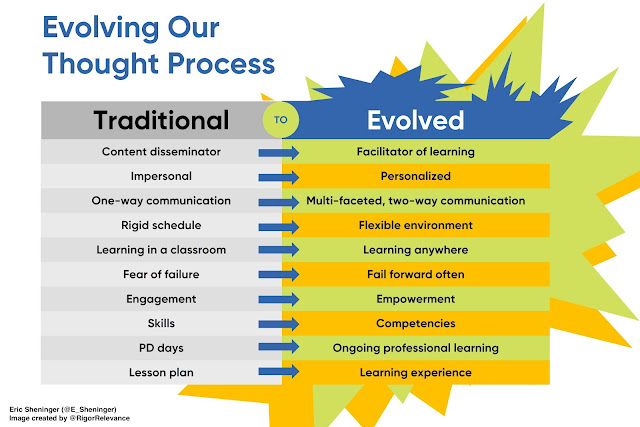It is quite hard to keep up with all the exponential changes we are experiencing. Take technology for example. We get used to a device or app and before we know it there has been a huge update that alters the experience or it’s gone and replaced by something else. I think we can all agree that disruptive change is not the standard in society, but the question becomes how is this impacting education? Honesty is the first step to grow and improve. As you take a critical lens to your practice and that of your colleagues or school, what do you see? Learner success relies on our openness to challenge conventional thought processes in order to evolve.
I shared the following in Disruptive Thinking in Our Classrooms:
I would wager that many of our assumptions in education stem from how we were taught throughout our own educational journey. Others were likely adopted based on how we were led or the ways in which teaching, learning, and leading was modeled for us. In either case, once beliefs are established, people have a difficult time changing them when challenged. In order to be our best selves—and best serve our students—what we embrace can and should evolve over time.
While TTWHADI (that’s the way we have always done it) can still lead to positive or even better results, the fact remains that it can also have a stagnating effect. Traditional does not always mean better, regardless of the fact that it might have worked for you or your stakeholders. Take a look at the chart below to see where there is an opportunity to think differently and grow. I developed it after re-reading chapter 2 of Disruptive Thinking.
The purpose of the chart above is to be a catalyst for collaborative conversations or individual reflections to spur growth. Elizabeth Thorton provides some good food for thought:
In order to change our lives and ultimately change our world, we must start by examining our own mental models: our beliefs, assumptions, and expectations about the way the world is and the way things ought to be. We think and act through our mental models. What we fundamentally believe about ourselves, what we believe to be true, what we have decided is important to us, what we focus on, is often what our experience will be.
The mind can be either an asset or a detriment to growth. My hope is that the chart presented in this post can be used to develop questions about where you are, but more importantly where you want and need to go for the betterment of kids. To prepare them for a disruptive world we must embrace an evolved thought process.

Personalized makes such a difference. We were just part of a middle school graduation with each student with their own table, pictures, etc (small christian school) and it was so sweet.
ReplyDeletevanderbloemen.com